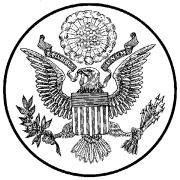Symbols of the United States

Symbols that have become American icons
by Beth Rowen
 Great Seal of the U.S. Related Links |
The Great Seal of the U.S.
On July 4, 1776, the Continental Congress appointed a committee consisting of Benjamin Franklin, John Adams, and Thomas Jefferson "to bring in a device for a seal of the United States of America." After many delays, a verbal description of a design by William Barton was finally approved by Congress on June 20, 1782. The seal shows an American bald eagle with a ribbon in its mouth bearing the device E pluribus unum (One out of many). In its talons are the arrows of war and an olive branch of peace. On the reverse side it shows an unfinished pyramid with an eye (the eye of Providence) above it. Although this description was adopted in 1782, the first drawing was not made until four years later, and no die has ever been cut.
The U.S. Flag
In 1777 the Continental Congress decided that the flag would have 13 alternating red and white stripes, for the 13 colonies, and 13 white stars on a blue background. A new star has been added for every new state. Today the flag has 50 stars.
Bald Eagle
The bald eagle has been our national bird since 1782. The Founding Fathers had been unable to agree on which native bird should have the honor-Benjamin Franklin strongly preferred the turkey! Besides appearing on the Great Seal, the bald eagle is also pictured on coins, the $1 bill, all official U.S. seals, and the President's flag.

Uncle Sam
The image of Uncle Sam, with his white hair and top hat, first became famous on World War I recruiting posters. The artist, James Montgomery Flagg, used himself as a model. But the term dates back to the War of 1812, when a meat-packer nicknamed Uncle Sam supplied beef to the troops. The initials for his nickname were quite appropriate!
- More from U.S.
